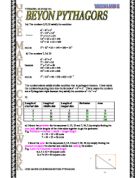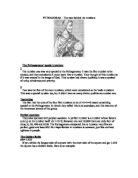- I drew a table to present my findings clearly.
Length of Middle side
- The sequence was 4, 12, and 24. To find the next sequence I drew a table as there was more than one difference.
The table shows that the first differences in the table are not the same therefor, I then worked out the second difference. I found the second differences to be constant – all 4
This pattern enabled me to calculate the fourth term (highlighted in blue). I added 4 to the first difference in series (4 + 12 = 16), the sum was then added to Un in series (16 + 24 = 40).
- I extended the table to see if I cold notice any other more reliable patterns.
Another pattern I noticed was that if you multiplied by a whole number Un was found, by doing this I further noticed that the difference between the multiples was 2.
E.g.
if 1 x 4 = 4
2 x 6 = 8
3 x 8 = 24
then 4 x 10 = 40
- From this information I could form a formula by finding the number that you multiply n with to get Un. So I formed the formula 2n +n, that would equal the number that you multiply. Once I found this I then knew that by mutilplying it by n I could get Un.
E.g. (2n +n) x n = Un
(2 x 2 + 2) x 2 = 12
(2 x 3 + 2) x 3 = 24
(2 x 4 + 2) x 4 = 40
Length of the Longest side
- The sequence was 5, 13, 25. To find the next number in the sequence I used the same method as I did to find the middle length as they both followed similar patterns
The table shows that the first differences in the table again are not the same, therefor I then worked out the second difference. I found the second differences to be constant – all 4. This pattern enabled me to calculate the fourth term (highlighted in blue). I
added 4 to the first difference in series (4 + 12 = 16), the sum was then added to Un in series (16 + 24 = 40).
-
Another pattern I noticed was that if you added 1 to the middle length of the same sequence then the longest length was obtained.
E.g.
if 4 + 1 = 5
12 + 1 = 13
24 + 1 = 25
then 40 + 1 = 41
I further checked that the 4th term was correct by checking that the sequences satisfied a similar condition of ( smallest number )2 = ( middle number) 2 = (largest number) 2
E.g.
if 32 + 42 = 52
then 92 + 242 = 90 2
because 92 + 242 = 81 + 576 = 657 = 412
Hence this means that all the equations are pythagrean triples because they all satisfy the condition a2 + b2 = c2
Perimeter
I found the perimeter after I had worked out all three lengths. I then added all the sides of the sides to get the perimeter. The equation for the perimeter is shortest + middle + longest length. So I used this to find the perimeter.
E.g.
If 3 + 4 + 5 = 12 units
5 + 12 +13 = 30 units
7 + 24 +25 = 56 units
then 9 + 40 + 41 = 90 units
Area
I found the area by using the equation Area = ½ ( length x width). As it is a Pythagorean triple I knew that these lengths would form a right-angled triage.
E.g.
If ½ (3 x 4 ) = 5
½ (5 x 12) = 30
½ x (7 x 24) = 84
then ½ x ( 9 x 40) = 90
I extended the table using lengths of positive integer. I started by looking at triangles which the shortest side is an odd number of units in length. This would enable me to work out the sequence in relation to which term it is.
Predictions
From the patterns I have previously noted I predict that the following four terms are correct.
Shortest length
I predict that the 5th term for the shortest length will be 11 because using the patterns identified I know that if you add 2 to the previous term it will equal the next term.
E.g. 9 = 2 = 11. I also predict that a will be 2 because I notice that the difference is 2 also.
I will test that this prediction is correct I will work out the formula. It is a linear equation because the difference between any two consecutive terms is the same.
Length- linear equation, tn =an + b.
Finding the rule
So I will be finding a rule for the sequence 3, 5, 7, 9…
The table above shows that the difference between any two consecutive terms is 2.
The rule is tn = 2n + a
t1 = 2 x 1 + a ( replacing n by 1 )
3 = 2 + a (since t1 =3)
1 = a (subtracting 2from both sides)
Hence the rule is tn = 2n + 1
- I noticed a connection between the rule for the sequences and the row of 2’s. This is that the rule has 2 in it and the second row of difference is also 2.
Testing & proving
To test the formula is correct will write down the first eight sequences given by the rule. tn = 2n + 1
- Replace n by 1, 2, 3, 4, 5, 6, 7, 8
t1 = 2 x 1 + 1 t2 = 2 x 2 + 2 t3 = 2 x 3 + 3 t4 = 2 x 4 + 4
= 3 = 5 = 7 = 9
t5 = 2 x 5 + 5 t6 = 2 x 6 + 6 t7 = 2 x 7 + 7 t8 = 2 x 8 + 8
= 11 = 13 = 15 = 17
-
I will also test the formula by using the rule to find the 18th term of the sequence.
Using tn = 2n + 1, t18 = 2 x 18 + 1
= 37
- I can even use the formula in an algebra equation to find the term of a sequence 18.
Using tn = 2n + 1, 18 = 2n + 1
I can solve the equation 18 = 2n + 1 to find n. using the balance method the solution is: 37 = 2n + 1
36 = 2n (subtracting 1 to each side)
18 = n (dividing both sides 2)
Therefor the t18 = 37. That is the 18th term is 37.
Overall my results proved to agrere with my original prediction as I used a linear equation which tested with other methods was correct.
Prediction
Using the patterns found earlier I predict that the four terms in the table 9pg5 0 are correct.
Middle length
I predict that the 5th term will be 60 because the difference between the difference of the previous term is 4. I therefor know that it is a quadratic equation because the difference between the difference of any two consecutive terms is the same. The difference method below enables me to predict that the highest power of n in a rule for a sequence is n2 because it goes to the second difference. If the sequence were to go to the third difference then it would be n3.
A quadratic rule for a sequence is tn = an2 = bn + c. The following equations will aid me in my investigation to make another prediction. There is a connection between the second row of difference and a.
tn = 2n2 + 3 tn = 3n2 + 5n
There is a relationship between the second row of difference and a. This is that the second row of difference halved is equal to a. Therefor I predict that if the second row of difference is 4 then a will be equal to 2.
Finding the rule
I will investigate further to find b and c
I can then use this to find the quadratic rule for the sequence 4, 12, 24, 40….
I will investigate further to find ba and c. For tn = an2 = bn + c.
4 12 24 40
8 12 16
- 4
2a = 4 3a + b = 8 a + b + c = 4
a = 2 3 x 2 + b = 8 2 + 2 + c = 4
6 + b = 8 4 + c = 4
b = 8 – 6 c = 4 – 4
b = 2 c = 0
The rule is 2n2 + 2n
Testing and proving
-
To test the formula is correct I will write down the first eight sequences given by the rule. I can then compare them with those I got using the patterns I noticed. Using tn = 2n2 + 2n.
t1 = 2 x 12 + 2 x 1 t2 = 2 x 22 + 2 x 2 t3 = 2 x 32 + 2 x 3
4 12 24
t4 = 2 x 42 + 2 x 4 t5= 2 x 52 + 2 x 5 t6= 2 x 62 + 2 x 6
40 60 84
-
I will also test the formulae by using the rule to find the 8th term of the sequence
Using tn = 2n2 + 2n, t8 = 2 x 82 + 2 x 8
= 144
- I can also use the formula in algebra equation to find the term of the sequence 8.





